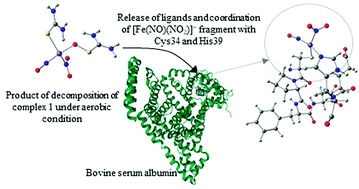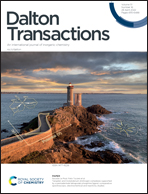Albumin as a prospective carrier of the nitrosyl iron complex with thiourea and thiosulfate ligands under aerobic conditions†
Abstract
High-molecular-weight dinitrosyl iron complexes (DNICs) are formed in living systems and are a stable depot of nitrogen monoxide (NO). In this work, using experimental and theoretical methods, we investigated the interaction of their synthetic analog, a promising cardiotropic complex of the composition [Fe(SC(NH2)2)2(NO)2]2[Fe2(S2O3)2(NO)4], with bovine serum albumin (BSA) in aqueous aerobic solutions. We suggested that, under these conditions, the decomposition product of the initial complex with oxygen, the [Fe(NO)(NO2)]+ fragment, can bind in the hydrophobic pocket of the protein. As a result of this interaction, high-molecular-weight Fe(Cys34)(His39)(NO)(NO2) is formed. The binding constant of the complex with protein measured by the quenching of intrinsic fluorescence of BSA is 7.2 × 105 M−1. According to EPR and UV-spectroscopy data, the interaction of the complex with the protein leads to its significant stabilization. In addition to coordination binding, the studied complex can be adsorbed onto the protein surface due to weak intermolecular interactions, resulting in the prolonged generation of NO.



 Please wait while we load your content...
Please wait while we load your content...